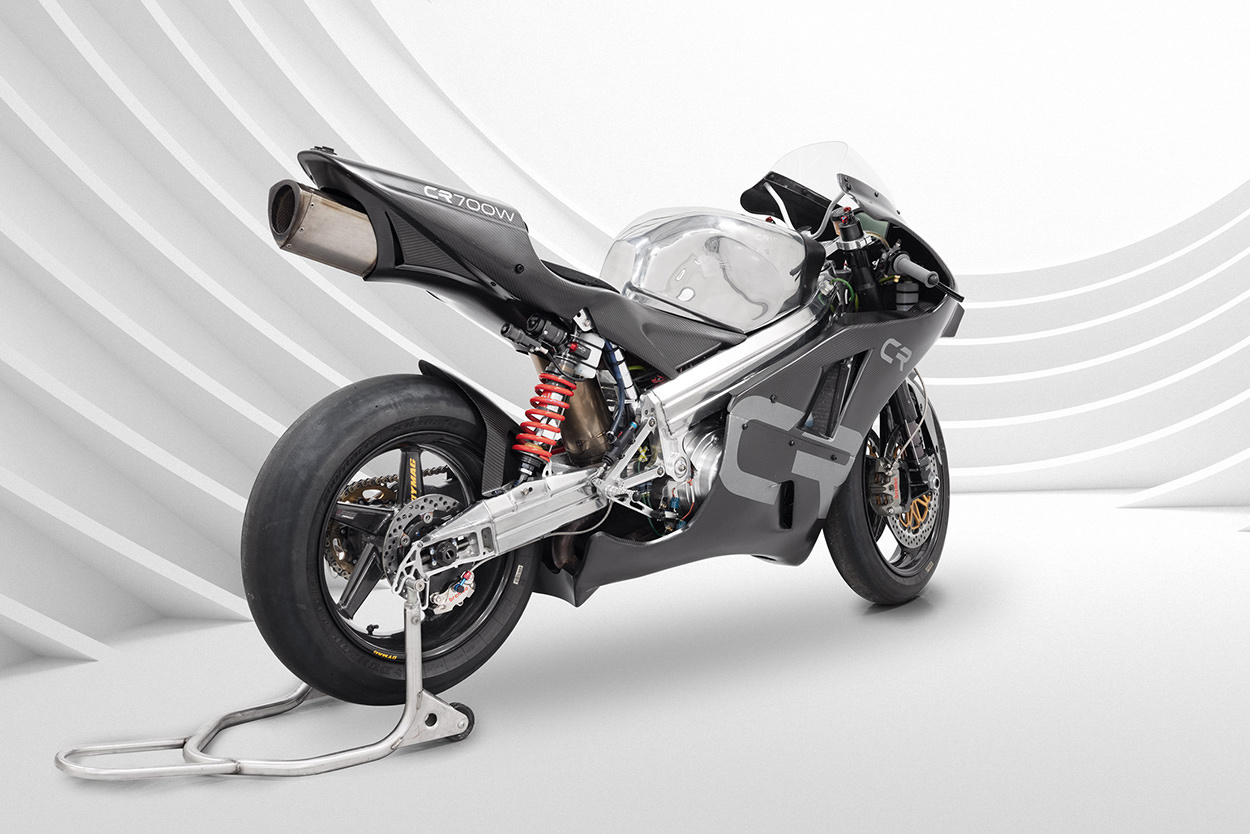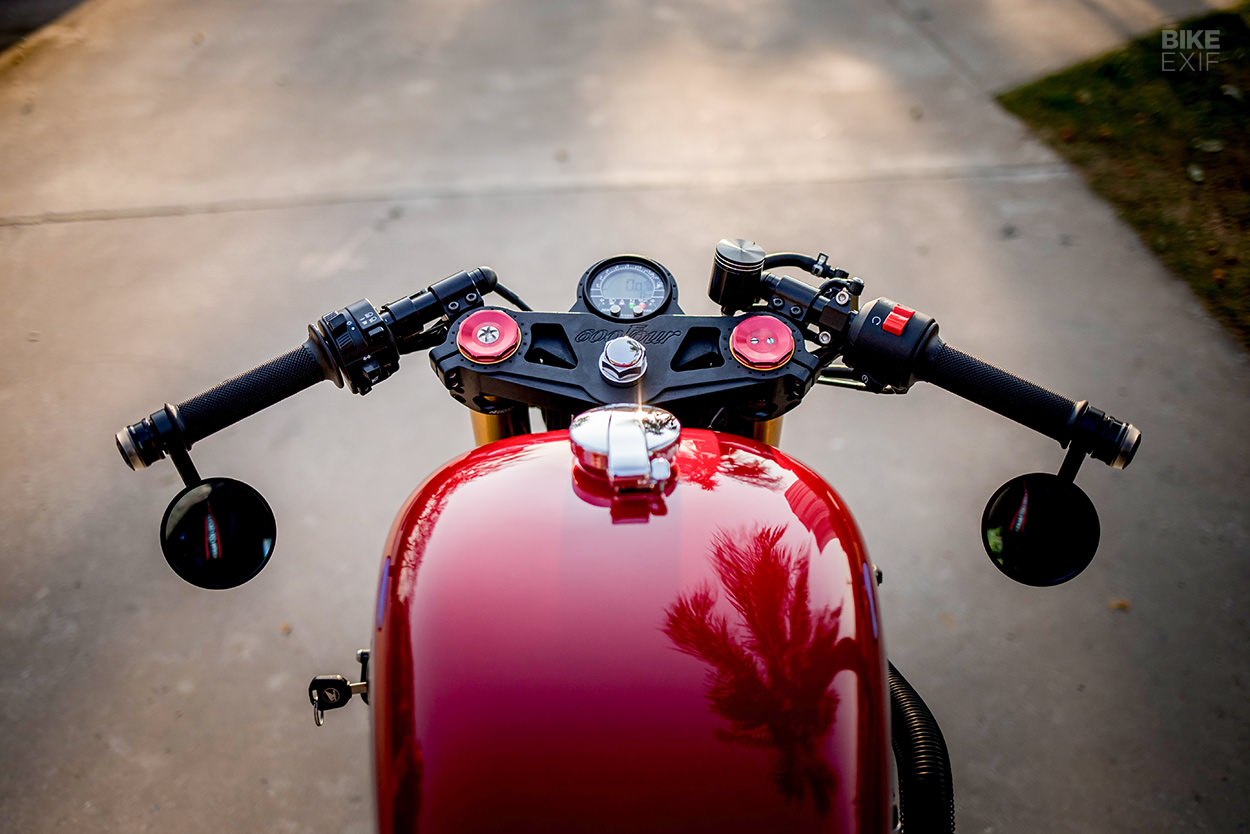
It’s a Boxer-heavy week, with two BMWs from Europe, and a Ural flat tracker from Siberia. But first, a look at the bonkers new Crighton CR700W, with a rotary engine pumping out well over 200 horsepower, and a Honda Hornet cafe racer from Brazil.

Crighton CR700W In the UK, Crighton Motorcycles and Rotron Power have just thrown the wraps off the new Crighton CR700W, and we’re swooning. Not because of its flawless lines, aluminum Spondon-derived chassis or sprawling carbon fiber real estate. Nope—this one has us hooked because of its motor.
It’s a 690 cc, fuel-injected rotary that puts out a mind-boggling 220 hp. That makes it one of the most powerful naturally aspirated motors ever made, relative to its capacity, with more hp-per-liter than a MotoGP race bike. And with a dry weight of 129.5 kilos [285 lbs], it has a power-to-weight ratio of 1.68 hp-per-kg.

As Asphalt & Rubber reports, the CR700W has been a long time in the making, and can trace its roots all the way back to Norton’s race program. A&R crunched the numbers, and describe the CR700W as “Moto3 weights with SBK power figures.”
Understandably, the bike is rather pricey and very limited. Only 25 will be made, and each one will be hand built by Brian Crighton at the company’s facility in the UK. It takes £85,000 plus taxes [around $115,000] to get your name in the order book.

You’re getting a lot for your money though. The CR700W’s motor is built in-house, and paired with a custom ‘box from Nova Transmissions, and innovative cooling systems specific to the bike. The spec also includes Dymag wheels, Öhlins or Bitubo suspension, and Brembo brakes. [Crighton Motorcycles]

Honda CB600F Hornet by Retrorides by Lourenço The Honda Hornet isn’t a common donor for custom projects, but done right, it has tons of potential. This sharp Hornet-based cafe racer from Brazil’s Retrorides by Lourenço makes a strong case for the 97 hp four-cylinder Honda.
Retrorides is a family business, run by Jose Lourenço and his sons, Gustavo and Rodrigo. Rodrigo took point on this project, because of his love for, and knowledge of, Honda motorcycles. His idea here was to build a cafe racer with modern performance, but design touches inspired by the Hondas of the 70s.

“The first thing that bothered Rodrigo was the swingarm,” says Gustavo, “because the square design showed that the bike was from the 2000s. We built a jig to manufacture a new one with the same geometry as the original—but with a new design.”
The new trellis arrangement looks the part, and is complemented by the front forks from a Kawasaki Ninja ZX-6R. As the family’s in-house machinist, Gustavo CNC-machined a new set of aluminum triples, with a classic Honda “600 Four” motif etched into the top yoke. Then he fabricated a pair of aluminum hubs to lace a new set of hoops to.

Jose was responsible for shaping up a custom fuel tank, after the guys tried and abandoned the idea of using a Honda CB750 tank on the bike. But the project stalled when he was hospitalized with heart problems—and told by his doctor to down tools.
“We left the tank on the bench waiting for his return to the workshop,” says Gustavo. “Every time we looked at this tank on the bench we missed him a lot, and we were apprehensive about his health, because we didn’t know what could happen to him.”

60 days later Jose was fully recovered and back at it, finishing off the tank with a CB750 gas cap to add a touch of elegance. The guys fabricated a new subframe too, adding a solo seat and a small tail bump.
The rest of the parts list includes an Acewell speedo, clip-ons with new grips and bar-end mirrors, a Koso headlight, and custom-made foot controls. There’s also a four-into-one exhaust system that’s improved the soundtrack, and helped the Hornet shed more weight.

There’s a host of subtler details too—like the blacked-out radiator fluid reservoir, and the color coding on the velocity stacks and rear shock spring. Wrapped in a delightful candy apple red finish with throwback Honda graphics, this Hornet rides the line between modern and classic flawlessly. [Retrorides By Lourenço]

BMW R80R by Renard Speed Shop In 1997, long after it first debuted, BMW released one last version of the R80GS. Dubbed the ‘Basic’ and finished in a simple white livery, it was a last chance for enthusiasts to own what was already shaping up to be a legendary machine. Now the Estonian shop, Renard, has built a handsome homage to the ‘Basic,’ and we’re in love with it.

Renard started with an earlier 90s-model BMW R80R, then swapped out the tank for an R80ST unit, which is near identical to the old GS tank. They also modified the subframe to accept an ST seat pan, then shaped their own seat to finish it off, with Alcantara upholstery.
From a distance, the white paint and period-correct tank graphics make this bike a dead ringer for an R80GS Basic. But Renard have worked in some neat details of their own, too. The BMW wears a sleeker rear fender than the GS did back in the day, with a smaller taillight, and has slimmer turn signals at both ends.

The side covers are actually modified Moto Guzzi parts, and the exhaust is a repurposed BMW F800 part. Up in the cockpit are new handlebar risers, and a Fuxxtech dash that combines the stock clocks with a row of LED warning lights.
Look closely, and you’ll also pick up a slight sparkle in the replica blue paint job on the frame.

A carbon copy of the Basic would require a 21” front wheel, but Renard couldn’t find a replacement that would work with the OEM brakes, so their version rolls on the donor’s original 18F/17R hoops. The suspension is stock too, but the motor’s not; it’s kitted with a 1,000 cc kit from Siebenrock.
As classic BMW restomods go, this one’s tough to beat. We’d happily park it in the Bike EXIF garage as a stylish daily runner. [Renard Speed Shop]

BMW R100RS by Cafe Racer Dreams Yes, Cafe Racer Dreams is still around (albeit with new ownership), and is still cranking out BMW Boxers at assembly-line speeds. They’re up to their 124th build now, and it’s a refreshing turn from the bobber style that the Madrid shop became known for.

This BMW R100RS plays by traditional cafe racer rules, but at a higher level than most. The slick black finish on the motor, blue frame and refreshing livery catch your eye first—but this BMW’s packing a respectable parts spec too.
Up front is a Suzuki GSX-R1000 front end, complete with its Showa forks and twin Tokico disc brakes. A set of Öhlins shocks do duty out back, connected to an all-new subframe. It even has sensible Dunlop Arrowmax tires.

Up top is a new half-fairing, mounted on a bespoke bracket system. Behind it is a set of adjustable Tomaselli clip-ons, flanking a CNC-machined top yoke with an integrated Motogadget dash. The grips are Vans ‘waffle’ items, and a set of Highsider mirrors hide cleverly integrated LED turn signals.
CRD also installed Tarozzi foot pegs, custom fenders, and a pair of low-slung GPR exhaust mufflers. Tidy work from the Spanish veterans. [Cafe Racer Dreams]
![]()
Ural IMZ M-72 by Hammerbike Customs Vintage Ural customs are a rare sight, but you know what’s rarer? A vintage Ural flat tracker, that’s what.
This adorable oddity is based on a 1954 Ural IMZ M-72, and it’s the work of Roman Molchanov at Hammerbike Customs in Novosibirsk, Siberia. Roman’s worked with the M-72 before, which is basically a knock-off of the late-1930s BMW R71. But this time, he had the itch to build a flat tracker with it.
![]()
“I like flat trackers and I like flathead engines too,” he tells us. “So I decided to put them together.”
The polished exterior of the Ural motor hints at an overhaul, but we were surprised at just how extensive the work was. Roman rebuilt it with forged pistons and modified cylinder heads, increased the compression ratio and lightened the flywheel. It’s also got a racing cam and a new ignition—all mods that, according to Roman, mimic the racing motors Ural built in the 1950s.
![]()
Roman’s Ural wears a surprising array of scalped parts too, including Buell forks and Honda Comstar wheels. And despite its age, it’s sporting a full complement of stainless steel fasteners. Handmade touches include the high-riding exhausts and the air filter.
Finished off with a new seat, tracker bars and a Harley-esque orange paint job, Roman’s Ural flat tracker is surprisingly fetching. He claims this is the first M72 flat tracker in the world, and he’s probably right—which is why this bike very cheekily wears #1 plates.
[Hammerbike Customs | Images by Alexander Kozlov]
![]()